Sample Lexical Functional Grammar Research Paper. Browse other research paper examples and check the list of research paper topics for more inspiration. If you need a research paper written according to all the academic standards, you can always turn to our experienced writers for help. This is how your paper can get an A! Feel free to contact our research paper writing service for professional assistance. We offer high-quality assignments for reasonable rates.
1. Introduction
Lexical Functional Grammar (LFG) is a theory of language structure dealing with the syntax, morphology, and semantics of natural languages. It is different from other theories in having several parallel representations for sentences, each with its own architecture and vocabulary, subject to its own organizational constraints, and linked by principles of correspondence (mappings), not derived from one another. LFG is thus a constraint-based nonderivational unification model, unlike other generative grammar models such as Principles and Parameters or Relational Grammar. There is an extensive international community of scholars working within an LFG framework; it has been used to describe an impressive array of languages from various families and typological groups. Current research in LFG includes the role of morphology in language structure, semantic representations, and computational implementation; as well as an Optimality Theory-based model of LFG.
Academic Writing, Editing, Proofreading, And Problem Solving Services
Get 10% OFF with 24START discount code
2. Background
From its inception in the late 1970s LFG has been concerned to be a model that is typologically grounded, computationally implementable, and consistent with psycho-linguistic understanding of language acquisition and comprehension. Bresnan (1982) sets out the original model and describes individual languages.
LFG emphasizes analysis in ‘lexical’ and ‘functional’ terms, rather than purely as phrase structure configurations (and movement of elements from one configurational position to another). Arguments in favor of separating constituency and functional representations (see Bresnan 2000, Carnie 2001, p. 339, Falk 2001) are discussed in Sects 2.1 and 2.2.
2.1 Structure–Function Mismatches
These mismatches occur where there is an imperfect correspondence between constituency and function, e.g., ‘talked about’ requires a Noun Phrase (NP) object and cannot have a tensed complement clause (CP) object:
(1) We talked about [NP the fact that he was unhappy NP] for weeks
(2) *We talked about [CP that he was unhappy CP] for weeks
However, if the CP occurs as a topic in the initial position the sentence is perfectly grammatical:
(3) [CP That he was unhappy CP] we talked about for weeks
Transformational models would be required to move the CP from a post-predicate position where it cannot actually occur, while LFG is able to capture the difference in grammaticality in terms of functional differences (topic versus object—see Sect. 2.2).
2.2 Non-Configurational Languages
In these languages word order is free and sentences have a ‘flat’ structure: there is no evidence for phrasal constituency asymmetries that distinguish grammatical functions. Non-configurational languages are typically ‘dependent-marking’ (case morphology encodes functional information), or ’head-marking’ (agreement morphology distinguishes functions such as subject and object). Jiwarli (Western Australia) is a dependent-marking non-configurational language: case marking codes function; word order is free and semantically related items can appear discontinuously:
(4) Juma-ngku ngatha-nha nhanya-nyja
child-erg 1sg-acc see-past
ngulu walhirrkura-lu
that-erg naughty-erg
‘That naughty child saw me’
Here the subject appears split at the beginning and end of the clause (all elements are marked for the same ergative (transitive subject) case); any other ordering or reordering of words is perfectly grammatical in Jiwarli, thus:
(5a) Ngulu juma-ngku ngatha-nha
nhanya-nyja walhirrkura-lu
(5b) Ngatha-nha walhirrkura-lu nhanya-nyja
ngulu juma-ngku
(5c) Nhanya-nyja ngatha-nha ngulu
juma-ngku walhirrkura-lu
all mean ‘That naughty child saw me’ (see Austin and Bresnan 1995, Austin 2001). In non-configurational languages constituency and function must be separately represented, unlike configurational languages (such as English) where the Verb Phrase constituent linking Verb and Object (but not Subject) allows function to be expressed in constituency (and word order) terms.
3. Parallel Structures
LFG analyses sentences in terms of (at least) four parallel structures:
- c-structures represent constituency facts (word order and phrasal grouping) in the form of contextfree phrase structure trees of the usual X-bar theory type;
- f-structures represent functional information (grammatical functions such as SUBJect and OBJect, and discourse functions like TOPic) in the form of matrices of attribute-value pairs. Attributes may be morphosyntactic features like tense or number, or grammatical functions;
- a-structures represent predicate-argument information such as the number and type of arguments and their thematic role (such as Agent, Patient or Location), stated as arrays of predicates and argument slots;
- σ-structures represent semantic information through deductive assemblage of meanings based on reasoning subject to constraints; σ-structures use a linear logic building on a-structure information. There may be other parallel structures, such as thematic-structure representing discourse pragmatic information, or phonological-structure representing sounds; they have not been elaborated in LFG work to date.
The parallel representations are linked by correspondence principles where information of one type can be mapped to other structures. Thus c-structure nodes in a configurational language map to grammatical function attributes in the corresponding fstructure (see below).
3.1 C-structure
Constituency information is represented as context free labeled phrase markers (trees). LFG c-structures adopt the X-bar model of head-dependent relations; ‘functional’ elements such as Determiners, Complementizers and Inflections are co-heads of lexical elements such as Nouns and Verbs. C-structures are subject to the lexical integrity principle: the minimal cstructure elements are whole words, not parts of words or empty categories. No movement of c-structure constituents (such as V to I movement) is allowed, unlike other syntactic theories. Syntax cannot see into the internal composition of words. An example of a cstructure is:
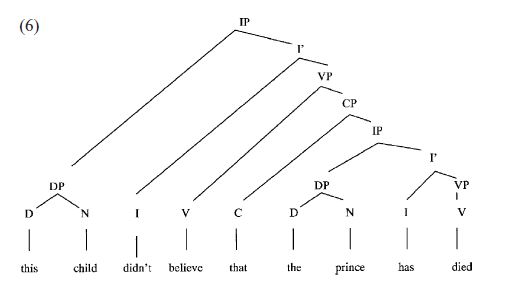
LFG uses lexical category information to deal with similarities in distribution that are captured by movement in transformational models, e.g. in English auxiliaries occur in the I c-structure position, however if there is no auxiliary then the verb may appear there, as in:
(7) This child didn’t believe that the prince has died.
(8) This child can believe that the prince has died.
(9) This child belie es that the prince has died.
In Principles and Parameters the inflected verb is moved from its V position at underlying structure to I position in a later structure. In LFG the distribution is captured by classifying an inflected verb like belie es as an I category marked for TENSE, but an untensed form like belie e as V. A consequence is that in sentences like (9) the c-structure VP contains no head V (a principle of economy on c-structures says that nodes should only be expanded when necessary).
In configurational languages c-structure nodes are annotated with functional equations to pass information up from daughter to mother nodes, using m(‘information about my mother’) and ↓(‘information about me’) symbolizations. Thus, in English the DP immediate daughter of IP (‘this child’ in example (6)) is the subject of the sentence and annotated as ↑SUBJ=↓. A DP immediate daughter of VP will be annotated ↑OBJ=↓. Lexical heads like V and N simply have ↑=↓ annotations (i.e. they pass all their lexical information up to their mother nodes).
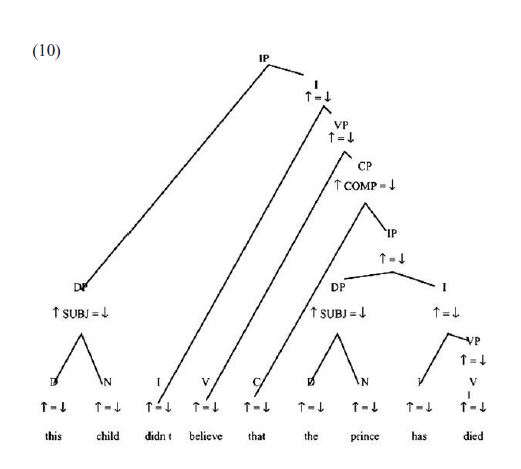
C-structures in configurational languages are generated by context free phrase structure rules with information-passing annotations, as in:
IP→DP I’
↑SUBJ=↓ ↑=↓
In non-configurational languages morphology plays a major role in function assignment.
3.2 A-structure
LFG includes a richly articulated lexicon expressing all morpho-syntactically relevant information for individual lexical items; for predicational elements the number and types of argument and complement slots that they subcategorize for, as in:
(11) gives I (↑PRED)=‘give <Agent, Theme,
Recipient>’
(↑TENSE)=present
(↑SUBJ NUMBER)=sing
(↑SUBJPERSON)=3
A-structure and functional information (such as the Agent being the SUBJECT in simple transitive clauses) are related by lexical mapping correspondence principles (see Sect. 3.4.1).
3.3 F-Structure
F-structures capture functional information and are sets of paired attributes and values in an attributevalue matrix. Attributes are morpho-syntactic features (derived from lexical entries) such as TENSE or NUMBER, or grammatical functions such as SUBJECT and OBJECT. LFG has a richly articulated typology of grammatical functions, including argument and complement functions subcategorized for by predicates, and adjunct functions. It also has discourse functions like TOPIC and FOCUS. In configurational languages correspondence principles map from cstructure positions to f-structure functions (see Sect. 3.4.2).
An f-structure for the sentence in (7) above would be:
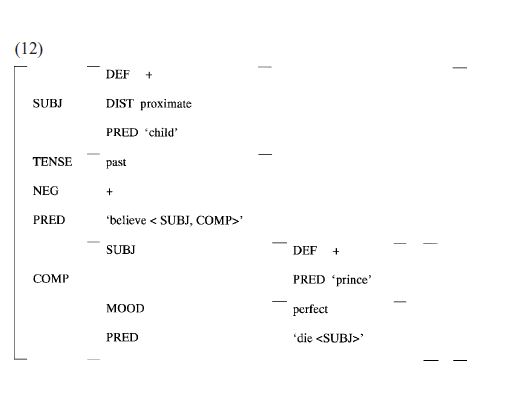
There are three layers of f-structure: the outer fstructure (corresponding to the whole sentence) has five attribute names: SUBJ, TENSE, NEG, PRED and COMP. Three attributes are features with simple values (PRES, +, ‘believe <SUBJ, COMP>’), while SUBJ and COMP are functions containing subordinate f-structures as values. These inner f-structures also have attributes and values – the SUBJ function of the embedded COMPlement takes a lower f-structure with grammatical features.
F-structure has an entirely different organization and vocabulary from c-structure (trees with constituents like N, DP and VP). F-structure attributevalue matrices are subject to well-formedness conditions of unification, i.e. the information within an fstructure must be:
- unique—attributes must have only one value
- complete—an f-structure must contain all the grammatical functions that a given predicate requires
- coherent—all the grammatical functions must be required by some predicate within the local f-structure LFG assumes f-structures have a degree of universality: translationally equivalent sentences in different languages have identical f-structures, even if their c-structures are quite different (as they would be for English and Jiwarli, for example).
3.4 Correspondence Principles
Central to LFG are correspondence or mapping principles relating the several parallel and independent representations of sentences.
3.4.1 A-Structure To F-Structure Mapping. Lexical mapping theory establishes correspondences between a-structure thematic roles and f-structure grammatical functions. LFG has four core grammatical functions: SUBJECT, OBJECT, OBJECTθ (thematically restricted ‘second object’ in sentences like ‘Bill gives John money’) and OBLIQUEθ (obliques with a range of thematic roles), decomposable into two features:
- [±r] for semantically restricted functions; OBJECTθ and OBLIQUEθ will be [+r]
- [±o] for object-like functions, OBJECT and OBJECTθ will be [+o]
This gives:
SUBJ=[-r, -o] OBJ=[-r,+o]
OBLθ =[+r,-o] OBJθ =[+r,+o]
Grammatical functions are hierarchically ranked from least marked to most marked:
SUBJ>OBJ/OBLθ>OBJθ
Lexical mapping assumes a Universal Thematic Hierarchy (see Bresnan and Kanerva 1989) reflecting a scale of thematic prominence:
Agent>Beneficiary>Goal>Instrument>
Patient/Theme>Locative
and serves to link the hierarchy of thematic roles to that of grammatical functions in a predicatable fashion (thus Agent links to SUBJ in unmarked constructions, Theme to OBJθ and Goal to OBJ with verbs like ‘give,’ etc.).
Argument mappings can be affected by lexical rules which change a-structures. So, passive is a lexical rule which removes the highest argument and makes it unavailable for mapping (hence Agent is no longer able to be SUBJECT, but Patient or Recipient can be).
3.4.2 C-Structure To F-Structure Mapping. In configurational languages mapping from c-structure to fstructure is mediated by phrase structure annotations (see (10)) passing information from lexical items and structural positions. Information is mapped from phrase structure nodes to a ariable (corresponding to a pair of brackets in the f-structure matrix). Variables are resolved by an f-description, a set of functional equations for all the nodes in the tree. Consider just the subject DP in (7) above with variables indicated in (13).
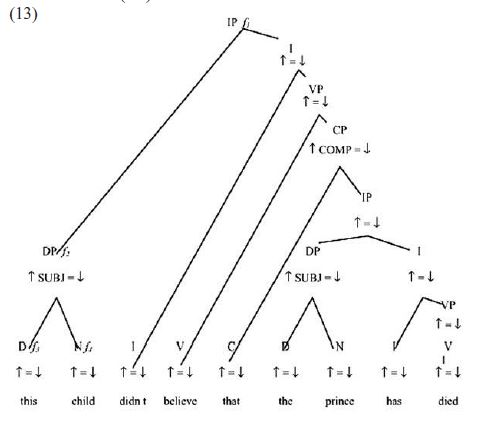
This gives the following functional equations:
(14) ( f1 SUBJ)=f2
( f2 DEF)=f3
( f2 DIST)=f3
( f2 PRED)=f4
These are resolved as:
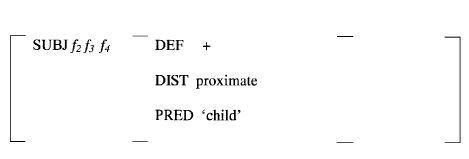
and so on for the rest of the nodes on the tree. Mapping is from c-structure configurations plus lexical information to f-structure matrices.
In non-configurational languages structural position does not define grammatical functions; this information must be derived from other sources. Nordlinger 1998 suggests that morphologically inflected forms are annotated to construct their local fstructure environment. Thus, in Jiwarli the ergative case form would construct a partial f-structure where the nominal bearing this case is SUBJECT (regardless of its c-structure position), accusative constructs an OBJECT function, etc. In head-marking languages agreement morphology is involved in resolution of functional equations to construct f-structures directly from morphological (lexical) information, without mapping from c-structure (annotated) positions.
4. Functions In Complex Sentence Constructions—Raising And Control
In non-finite complement clause constructions the subordinate verb may be missing a subject:
(15) Harry doesn’t like to speak Sumbawan
(16) Harry doesn’t seem to speak Sumbawan
The main clause subject ‘Harry’ is also understood as the subject of the subordinate predicate ‘speak Sumbawan,’ however:
- in (15) (often called a control construction) two thematic roles are involved: Harry bears a thematic relation to both ‘like’ and ‘speak’;
- in (16) (often called a raising construction) only one thematic role is involved: Harry bears a thematic relation to ‘speak,’ but not to ‘seem.’
In transformational grammars these two constructions are analyzed as having an empty category (or gap) as the subordinate subject; for control this is PRO, which obtains its reference from the main clause subject, and for raising it is a DP trace that remains after the subordinate subject has been moved up to the main clause:
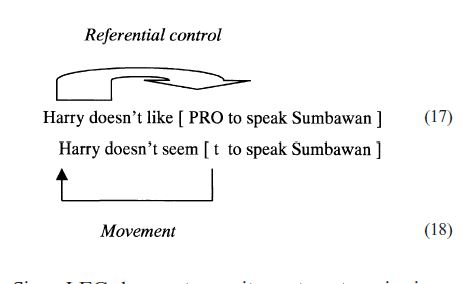
Since LFG does not permit empty categories in c-structure, the constituency of these two sentences types is identical; both have a main clause verb taking a VP’ (to VP) complement with no subject DP in c-structure:
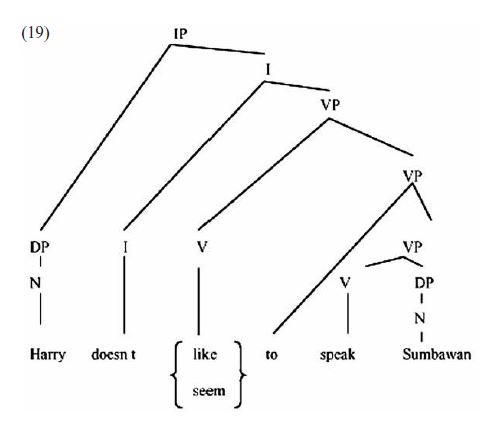
The grammatical function of VP’ is XCOMP, an open function complement missing a subject function in c-structure. The identity of this subject function in fstructure is resolved by functional control. The lexical entries for like and seem are annotated to indicate that their XCOMP’s SUBJect is informationally equivalent to their own SUBJect (for like the main clause subject is semantically selected by the verb (inside the <> brackets in the verb’s a-structure); for seem it is not (outside the <> brackets):
(20) like V ( ↑PRED)=‘like <( ↑SUBJ)
(↑XCOMP)>’
(↑SUBJ)=(↑XCOMP SUBJ)
(21) seem V (↑PRED)=‘seem <(↑XCOMP)>
(↑SUBJ)’
(↑SUBJ)=(↑XCOMP SUBJ)
The functional control equation is mapped to f-structure as a link between the main subject’s f- structure and the subordinate subject’s f-structure (the controller f-commands the controllee, i.e. is part of a less embedded f-structure):
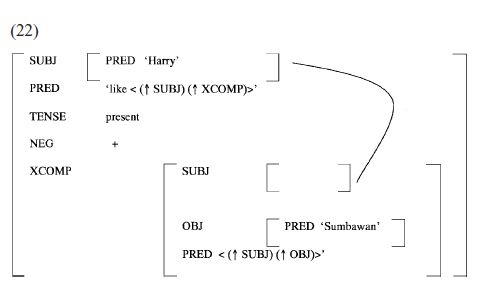
5. Long Distance Dependencies
In sentences like the following there is a dependency relationship between an element in sentence-initial position and a grammatical function later in the clause:
(23) What doesn’t Harry like to speak?
(24) Which analysis does Joan seem to prefer to write about?
(25) That person, I’ve never seen you talk to.
The distance between initial position and the site of the grammatical function assignment is potentially unlimited; these are referred to as long distance or unbounded dependencies. Transformational analyses have movement (called wh-movement or A-bar movement) with the sentence-initial filler being extracted and leaving a gap (or wh-trace empty category). LFG has no movement operations; long distance dependencies must be captured in another way.
There are several accounts of long distance dependencies in the LFG literature, the most recent use functional uncertainty (see Kaplan and Zaenan 1989, Bresnan 2000). Essentially a functional equation identifies the initial element bearing a discourse function (DF) such as TOPIC or FOCUS with a grammatical function (GF) such as SUBJECT or OBJECT later in the sentence. The path of this identification can be indefinitely long and passes through (in English) any number of COMPlement clauses—function assignment is thus uncertain. There are two approaches to the functional equation: outside-in functional un- certainty (Kaplan and Zaenan 1989) or inside-out functional uncertainty (Bresnan 2000). For the former the initial topic or focus position in a language such as English has a functional equation associated with it:
(26) (↑DF)=(↑COMP*GF)
This says: in f-structure identify the f-structure of an element bearing a discourse function with the f- structure of a grammatical function, passing through indefinitely many COMPlements (indicated by the Kleene star operator *). This identification is signaled by a link in f-structure, and any restrictions on the long distance dependency (so-called island constraints) can be stated in terms of the path from filler to gap through the f-structure. (There is also a link for raising and control structures, however this is strictly local and lexically determined.) LFG claims that c-structure information is irrelevant for long distance dependencies, contrary to transformational accounts. Evidence this is correct comes from category mismatches between the filler and gap (see example (3)); it is functional identification which is relevant.
6. Current Issues
Among areas currently of concern in LFG are:
- the role of morphology in language structure, including the contribution of morphology to functional structure independently of c-structure, the relationship between inflectional morphology and syntax (and the notions of functional category, competition and blocking), and the interface between morphology and syntax (including concepts of what it is to be a word, and how to analyze predicates that are morphologically complex, such as serial verb or main verb-classifying verb constructions);
- the nature of semantic representations and σ-structure, especially the development of a ‘glue language’ to relate semantics and f-structures;
- computational implementation of LFG grammar models on large data sets, computer architectures (including grammar-translation) using a data-oriented probabilistic approach to LFG-parsed corpora (called DOP-LFG)
- the relationship between Optimality Theory (OT) and LFG models, exploring how violable constraints can be added to LFG analyses to give a preference ranking between them, and how OT approaches to syntax can be informed by research on parallel constraint-based models such as LFG.
7. Conclusion
Lexical Functional Grammar is a powerful approach to linguistic analysis and theory building that has been practiced for over twenty-five years. It is characterized by parallel independent but related linguistic structures that each contribute information in their own constrained fashion. It has been applied to a wide range of languages and is being actively developed for linguistic analysis, theory construction, and computational modeling with the goal of analyzing and understanding the nature of human language.
8. Further Reading
Falk (2001) is a very readable introduction; see also Chapter 13 of Carnie (2001). Bresnan (2000) is a more advanced state-of-the-art presentation of the theory and several new ideas. Bresnan (1982) and Dalrymple et al (1995) contain classic articles that remain relevant, though now somewhat dated.
Much material is available on the internet at www-lfg.stanford.edu/lfg/ and clwww.essex.ac.uk/LFG/, and through the International Lexical Functional Grammar Association at: www-lfg.stanford.edu/lfg/ilfga/. There is also an LFG e-mail and discussion list: access is described on the web sites.
Bibliography:
- Austin P 2001 Word order in a free word order language: the case of Jiwarli. In: Simpson J, Nash D, Laughren M, Austin P, Alpher B (eds.) Forty Years On. Pacific Linguistics, Canberra
- Austin P, Bresnan J 1995 Non-configurationality in Australian Aboriginal languages, Natural Language and Linguistic Theory 14: 215–68
- Bresnan J (ed.) 1982 The Mental Representation of Grammatical Relations. The MIT Press, Cambridge, MA
- Bresnan J 2000 Lexical Functional Syntax. Blackwell, London
- Bresnan J, Kanerva J 1989 Locative inversion in Chichewa: A case study of factorization in grammar. Linguistic Inquiry, 20(1): 1–50
- Carnie A 2001 Syntax. Blackwell, London
- Dalrymple M, Kaplan R M, Maxwell J T III, Zaenen A (eds.) 1995 Formal Issues in Lexical-Functional Grammar. Center for the Study of Language and Information, Stanford University
- Falk Y 2001 Lexical-Functional Grammar: An Introduction to Parallel Constraint-based Syntax. Center for the Study of Language and Information, Stanford
- Kaplan, R M. and Zaenen A 1989 Long-distance dependencies, constituent structure, and functional uncertainty. In: Baltin M, Kroch A, eds. Alternative Conceptions of Phrase Structure. Chicago University Press, Chicago, pp. 17–42. [Reprinted 1995, 137–165]
- Nordlinger, R 1998 Constructive Case: Dependent Marking Nonconfigurationality in Australia. CSLI Publications, Stanford, CA




